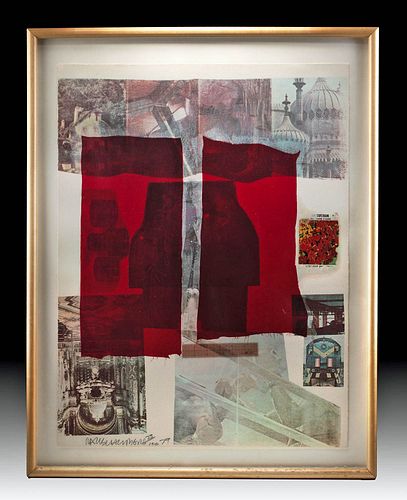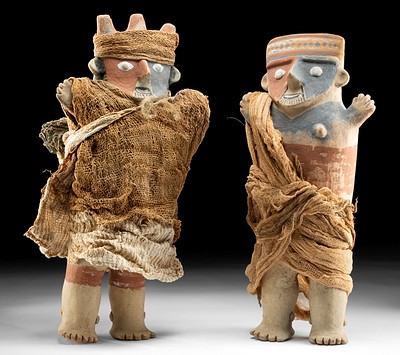Signed Rauschenberg Print "Why You Can Tell II" (1979)
Lot 149a
About Seller
Artemis Fine Arts
686 S Taylor Ave, Ste 106
Louisville, CO 80027
United States
Selling antiquities, ancient and ethnographic art online since 1993, Artemis Gallery specializes in Classical Antiquities (Egyptian, Greek, Roman, Near Eastern), Asian, Pre-Columbian, African / Tribal / Oceanographic art. Our extensive inventory includes pottery, stone, metal, wood, glass and textil...Read more
Categories
Estimate:
$3,000 - $6,000
Absentee vs Live bid
Two ways to bid:
- Leave a max absentee bid and the platform will bid on your behalf up to your maximum bid during the live auction.
- Bid live during the auction and your bids will be submitted real-time to the auctioneer.
Bid Increments
| Price | Bid Increment |
|---|---|
| $0 | $25 |
| $300 | $50 |
| $1,000 | $100 |
| $2,000 | $250 |
| $5,000 | $500 |
| $10,000 | $1,000 |
| $20,000 | $2,500 |
| $50,000 | $5,000 |
| $100,000 | $10,000 |
| $200,000 | $20,000 |
About Auction
By Artemis Fine Arts
May 19, 2022
Set Reminder
2022-05-19 10:00:00
2022-05-19 10:00:00
America/New_York
Bidsquare
Bidsquare : Fine Antiquities | Ethnographica | Fine Art
https://www.bidsquare.com/auctions/artemis-gallery/fine-antiquities-ethnographica-fine-art-9350
Featuring a very special collection of Fine Art from the Hollywood Hills, including Picasso & Rookwood ceramics! Also included are many fine examples of classical antiquities, ancient, and ethnographic art from cultures encompassing the globe. Artemis Fine Arts info@artemisfinearts.com
Featuring a very special collection of Fine Art from the Hollywood Hills, including Picasso & Rookwood ceramics! Also included are many fine examples of classical antiquities, ancient, and ethnographic art from cultures encompassing the globe. Artemis Fine Arts info@artemisfinearts.com
- Lot Description
Robert Rauschenberg (American, 1925-2008). "Why You Can Tell II" (1979). Screenprint in colors on wove paper. Hand signed, numbered 73/100, and dated in pencil on lower left. Published by Multiples, New York and Printed by Styria Studio, New York. With the blind stamp of the printer at lower left corner. A hand-signed, colorful Robert Rauschenberg screenprint with offset lithograph and collage entitled "Why You Can Tell II" from the suite "Nine Prints" featuring images of collaged photographs that Rauschenberg selected from books and magazines that bring disparate eras, cultures, and meanings together, set in an attractive, custom frame. Size of sheet: 30.4" L x 23" W (77.2 cm x 58.4 cm) Size of frame: 35.75" L x 27.875" W (90.8 cm x 70.8 cm)
Born in Port Arthur, Texas, Robert Rauschenberg studied at Black Mountain College where he was exposed to exciting artists such as Josef Albers and John Cage. Early on in his career, his Black Paintings and White Paintings justifiably earned the attention of the New York art scene. In addition, Rauschenberg met Jasper Johns who would be an important personal and professional influence; their relationship has been described as "one of the greatest love stories in modern art" (Duncan Ballantyne-Way "The Relationship Between Jasper Johns & Robert Rauschenberg" in "fineartmultiple" 2017).
Rauschenberg created memorable artworks for six decades. A master from the Pop Art era, he explored an eclectic array of materials and experimented with various techniques. Perhaps best known for his "Combines" - three dimensional sculptural collages that he created from seemingly ordinary found objects and discarded materials like tires, umbrellas, sheet metal, and newspapers - as well as vibrant silkscreen paintings which he first screen-printed, then painted over, and collaged photographs from books and magazines.
Rauschenberg was the first American to win the Golden Lion award at the Venice Biennale in 1964. From there, he went on to have solo exhibitions at the Guggenheim, Tate Modern, Centre Pompidou, and Moderna Museet, among other elite institutions. His art may be found in collections throughout the globe and has sold for tens of millions at auction; his high auction record is $88.8 million at Christie's in 2019.
Several important museums including the Museum of Modern Art in New York have collected "Why You Can Tell II".
Provenance: ex-Nancy and Dr. E.F. Simpson collection, Los Angeles, California, USA, acquired from 1970 to 2000
All items legal to buy/sell under U.S. Statute covering cultural patrimony Code 2600, CHAPTER 14, and are guaranteed to be as described or your money back.
A Certificate of Authenticity will accompany all winning bids.
PLEASE NOTE: Due to recent increases of shipments being seized by Australian & German customs (even for items with pre-UNESCO provenance), we will no longer ship most antiquities and ancient Chinese art to Australia & Germany. For categories of items that are acceptable to ship to Australia or Germany, please contact us directly or work with your local customs brokerage firm.
Display stands not described as included/custom in the item description are for photography purposes only and will not be included with the item upon shipping.
#171890This screenprint has not been examined outside the frame but appears to be in excellent condition. It is hand signed, numbered 73/100, and dated in pencil on lower left. There is a Styria Studio (printer) blind stamp at the lower left corner. Frame is excellent save some stains on lower end. Fitted with suspension wire and ready to display.Condition
- Shipping Info
-
All shipping is handled in-house for your convenience. Your invoice from Artemis Gallery will include shipping calculation instructions. If in doubt, please inquire BEFORE bidding for estimated shipping costs for individual items.
-
- Buyer's Premium



 EUR
EUR CAD
CAD AUD
AUD GBP
GBP MXN
MXN HKD
HKD CNY
CNY MYR
MYR SEK
SEK SGD
SGD CHF
CHF THB
THB













